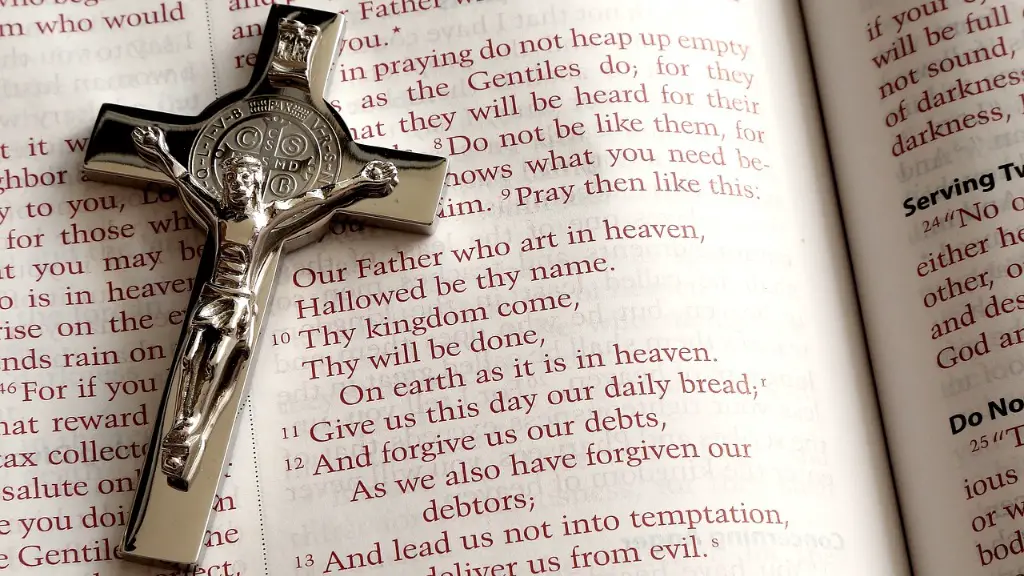Animal sacrifice has been around in many cultures for centuries, and is featured in the Bible in several places. For example, the story of Abraham’s sacrifice of Isaac, and later, the sacrificial offerings of the Jewish Temple. But at what point does the Bible show animal sacrifice coming to an end?
In the Bible, animal sacrifice is explained in detail in books such as Leviticus and Exodus, but these books also include instructions for offerings beyond the animal kind. Grain and oil offerings are mentioned, as well as animal sacrifices, so we can see that the sacrificial system was rather complex. In the book of Jeremiah, we see a clear indication that the custom of animal sacrifice is coming to an end. God mentions to the Jewish people that their offering of animals to him is meaningless, as he does not need them. This is seen as a sign that God is no longer satisfied with animal sacrifice, and that it is coming to an end.
In the book of Hebrews, we see a new view of animal sacrifice, as the writer mentions Christ’s death as a “once and for all” offering, indicating that animal sacrifice is no longer necessary. This is seen as the new covenant between God and humanity, and it marks the end of animal sacrifice in the Bible.
The end of animal sacrifice in the Bible does not mean that it is no longer practiced in many cultures. Animal sacrifice is still practiced in some cultures as a way of offering thanks to the gods or honoring ancestors. Additionally, animal sacrifice in the form of a hunted animal or game is also still practiced in some hunter-gatherer societies today. So while animal sacrifice is no longer featured in the Bible, it is not completely gone from our world.
While animal sacrifice is seen as outmoded in many cultures today, it is clear that for thousands of years, it was an important portion of many cultures’ religious beliefs and practices. Animal sacrifice has been utilized to express religious devotion and has been seen as necessary to connect with the gods. The Bible’s inclusion of animal sacrifice and its eventual move away from the practice can be seen as an acknowledgement of how customs and beliefs change over time, something that is still true today.
Physical Effects of Animal Sacrifice
Though it may appear on the surface that animal sacrifice would lead to a field of rotting flesh, animal sacrifice in the Bible was actually performed in a very respectful way. The Old Testament instructed that animals only of the best breed and health be used for sacrifice, and that only priests or those ordained by priests could perform the ritual. The animals were slaughtered in a specific way, with their throat slit, and the blood and fat of the animal were poured onto an altar as an offering for God. Animal sacrifice was also seen as a way to come close to God, as the human was offering a life in exchange for the chance to be close to God.
In exchange for the animal, the person performing the sacrifice could receive a blessing from God, or their sins could be forgiven. Animal sacrifice was a powerful offering and could be seen as a way to show respect and devotion to God. Additionally, some scholars believe that the blood of the animal symbolically cleansed the person’s soul, allowing them to be cleansed of any sins they may have committed.
Animal sacrifice is a practice that dates back thousands of years, and one that is still remembered today in many cultures. However, for the Bible, it has moved away from this practice and has instead embraced a belief system which eschews animal sacrifice in favor of other offerings. Nevertheless, animal sacrifice has played an important role in the history of many religions and cultures, and the Bible’s move away from the practice can be seen as an acknowledgement of how beliefs evolve over time.
Social Effects of Animal Sacrifice
The effects of animal sacrifice on various social aspects of a community must also be taken into consideration. Animal sacrifice was often tied to certain events or celebrations, such as wedding ceremonies, funerals, or various feasts. These events often served as a way to unify the community and build a stronger bond among the people.
Additionally, animal sacrifice could be seen as a way to offer gifts to the gods or to gain favor or protection from them. Offerings of living beings were often seen as symbolic of the connection between human and divine, a connection that would hopefully bring about protection and success. By offering a part of themselves, either in the form of a living animal or some other offering, the people believed that the gods would take notice of them and reward them with happiness and prosperity.
The symbol of the sacrifice, which often involved killing an animal, was also a way for people to show respect for life. In many cultures, animals were seen as sacred and connected to life. The act of killing an animal in sacrifice was therefore seen as a way to show respect and reverence for the animals and the life they represented.
Animal sacrifice was a powerful and meaningful practice for many cultures, and its practice in the Bible can be seen as an acknowledgement of this. Though it has now been removed from the Bible and is not practiced by mainstream religions, its impact on different cultures and social customs is still felt today.
Cultural Impact of Animal Sacrifice
The practice of animal sacrifice has been around for centuries and has greatly impacted cultures throughout the world. It has been used as a way to honor ancestors, showing respect for their memory, as well as to honor gods or gain favor with them. As such, animal sacrifice has formed the foundation of some of the oldest and most powerful belief systems in human history.
The practice of animal sacrifice also finds its way into literature, art, and music. Numerous works feature animal sacrifice, such as Gilgamesh, The Bible, and the myths of Ancient Greece and Rome. This speaks to the power and importance that animal sacrifice has had throughout time, and it continues to resonate in our culture today.
In the modern day, animal sacrifice is no longer a part of the mainstream religious belief system, though some smaller sects still practice it. Animal sacrifice has been replaced by more modern forms of worship, and its legacy is now seen in literature, art, and music, and in the various cultures that have adopted it over the centuries.
Modern Meaning of Animal Sacrifice
In the modern day, animal sacrifice has taken on a new sense of meaning. As a symbol of respect and devotion, it can still be seen as a powerful ritual, but it is no longer tied to any specific religious belief. Instead, it has become a symbol of respect for life and the act of giving, whether in the form of an animal or a non-living offering.
Animal sacrifice is also seen as a way to honor the dead, and as a way to build a connection between the living and the divine. Through sacrifice, it is believed that the gods will take notice of you and may reward you with protection or prosperity. In this modern sense, animal sacrifice is seen as a sign of gratitude and respect for life, as well as a way to build a connection with the divine.
Animal sacrifice has been part of human culture for thousands of years, and its power is still felt today. While it is no longer featured in the Bible, its impact can still be seen in many cultures, and it remains a powerful symbol of respect and devotion.




